This is a guest post by Dave Kirby, co-host of the GeekDad Podcast Network’s Dice Section show. Dave isn’t a dad, but he loves games and, even better, he actually has the free time to play them. You can find Dave on Twitter, which he promises he’ll start updating again.
2014 taught us a few harsh lessons about the risks of investing in video game Kickstarters and buying unfinished games through Steam Early Access. I’d already decided years before that I was through with buying any games before I’d consumed a glut of post-release reviews and impressions, but, even so, I couldn’t restrain myself from pre-purchasing Civilization: Beyond Earth. My disappointment with that game was a reminder that even buying a game billed as “complete” can leave you feeling swindled, let alone dropping a chunk of change on an Early Access game that may not evolve to include promised features or a Kickstarter project that may never bear any playable fruits at all.
It was with all this in mind that I grew tentatively excited about Darkest Dungeon over the past several months. Vancouver-based Red Hook Studios launched a slick Kickstarter campaign for the game early last year, and claims that the project had already been in development for nine months were easy to believe. The game looked great, and footage of its unique style made it clear that these fellows had more than tenuous promises to offer. Here was a thing already in a playable state, with a slew of interesting mechanics, some of which had been rarely explored in other games. Darkest Dungeon kept popping up as a blip on my radar: something to keep track of, something that I might only need to hear a handful of positive things about before jumping on board. The game became available through Steam Early Access on Feb. 3, and I’d heard just enough of those positive impressions to take the plunge. I’m quite glad I did.
Darkest Dungeon is a few things at once: town builder, roster manager, roguelike dungeon crawler, turn-based tactical RPG. None of these systems are terribly complicated, but they’re all satisfying, and so fundamentally intertwined that the full game is something entirely new. Perhaps the best analog to playing Darkest Dungeon is the experience one gets from FTL: Faster Than Light. Manage your infrastructure, manage your personnel, head into the unknown. Make choices that offer weal or woe. Survive deadly combat. Invest your newfound resources as you see fit–there’s never enough to go around–and start the process again, always grasping to stay ahead of increasingly difficult challenges. Repeat, repeat, repeat, until you can’t repeat anymore because everyone on your team just died. Start a new campaign, armed with hard-won knowledge and prepared to make it a bit farther, just a bit farther, this time.
You assume the role of a nameless expedition leader, a member of a family that once occupied a grand estate. The game’s introductory cinematic gives glimpses of pretty dark stuff that went down there in the past, smacking you in the face with a wonderful art style and excellent narration. The estate and surrounding grounds are now haunted, infested, inhabited, plagued, cursed, etc., and your task is to reclaim it all by sending parties of heroes into the Ruins beneath the manor, the Weald nearby, and other dungeonous environments.
In Darkest Dungeon‘s most interesting take on the dungeon crawler, however, you’ll find that your heroes are anything but the indefatigable barbarians and wizards of high fantasy. These warriors, rogues and priests are fragile creatures of limited health and sanity, and while losing them to injury in dungeons is a very real threat–the death of a hero in this game is quite permanent, and in true roguelike fashion, there’s no option to save and reload, so every decision and consequence is quite permanent. So too is the danger posed by Stress. Your heroes accumulate Stress as they’re exposed to, well, anything stressful, from an unexpected spike trap, to hunger pangs from insufficient rations, to the shock of seeing an enemy score a critical strike on a comrade, to the otherworldly terror of a many-tentacled, Lovecraft-inspired aberration. After each dungeon crawl is complete, the physical damage your heroes sustain is healed automatically, but Stress is most assuredly not. As you send them on successive adventures, your heroes will develop Quirks that define them–this Crusader is God-Fearing and eschews leisure activities other than prayer, while this Vestal is Unyielding and that much harder to kill. If a hero builds up too much Stress, however, she might develop a full-blown Affliction, her Masochism causing her to self-wound every round in combat or her Paranoia making it impossible for other heroes to offer beneficial spells or healing.
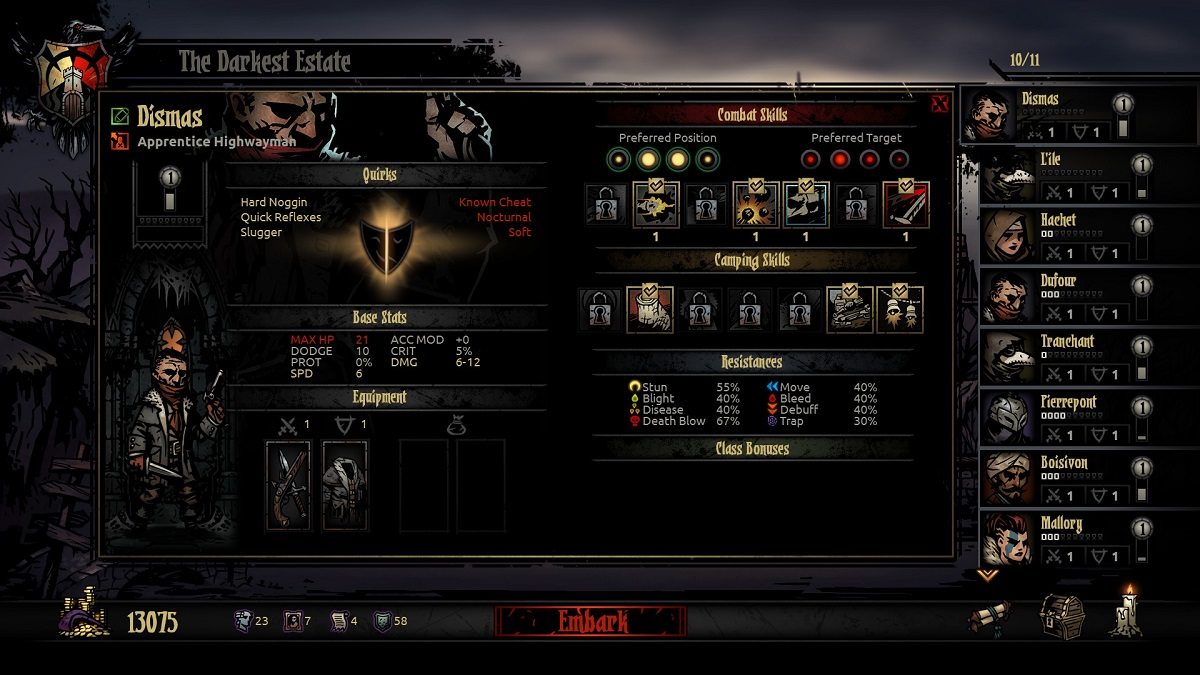
Managing your budding estate then becomes a juggling act. You’ll surely want to invest in the Stagecoach and Blacksmith, to recruit new heroes and upgrade their equipment, but you can’t overlook the Tavern or the Abbey, as your heroes must visit these establishments to reduce their Stress and cure Afflictions through gambling, meditation, self-flagellation, or the pleasures of the flesh. The Sanitarium is useful for curing negative Quirks like The Runs or a Torn Rotator Cuff, but then, so is the Guild, where heroes can learn new abilities and upgrade existing ones.
You’re always delightfully short on the resources to upgrade these facilities and the gold required to use them. The game forces meaningful choices every time you make it back to town, and at times it will drive you mad by sheer random chance: the Highwayman you have scheduled for some R&R is a Nymphomaniac and thus can only recuperate at the Tavern’s Brothel, but the estate’s damnable Caretaker is taking up its only slot! Without the resources necessary to pay for everything you want, you’ll find yourself scraping together a party of four heroes, hoping they retain enough sanity to complete a dungeon crawl and make it back with a stash of loot.
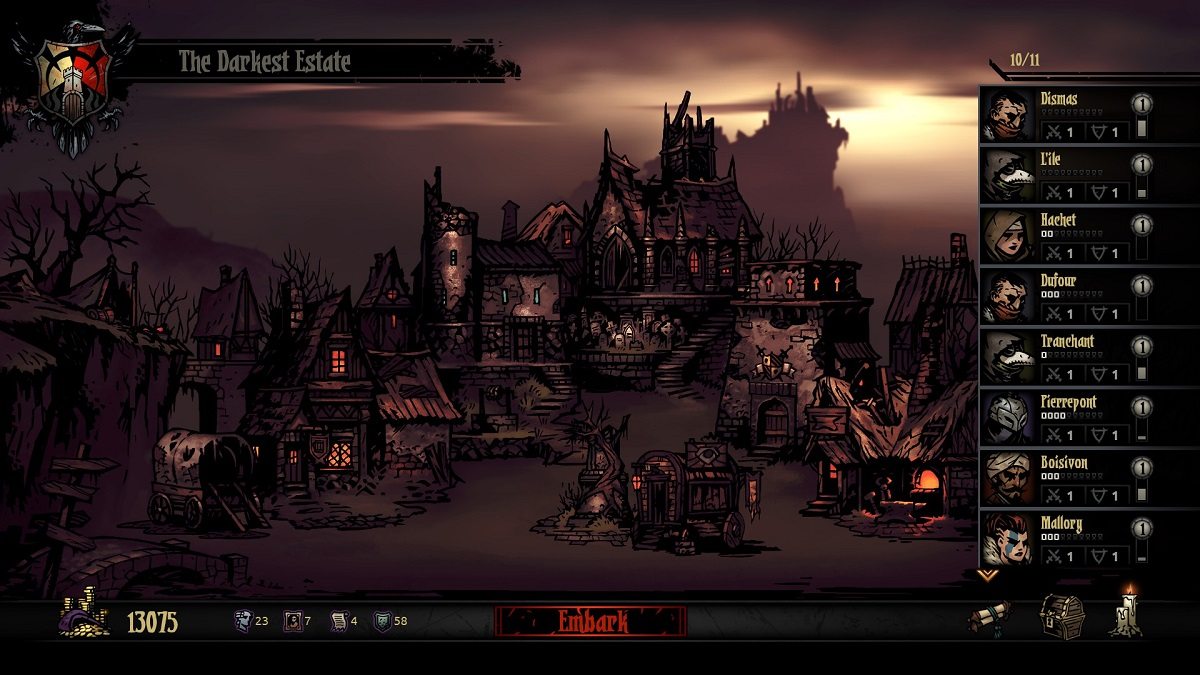
Dungeon-crawling and combat are both deceptively complex in Darkest Dungeon. Every individual choice is fairly straightforward: assemble a team of heroes, buy provisions for their expedition, send them into a randomly-generated dungeon environment. Move from room to passageway to room. Disarm traps, or fail to notice them and watch helplessly as your Bounty Hunter is shot by a poison dart. Risk a hero reading the arcane scroll made from human skin, or leave it alone. Use a Skeleton Key to open a locked chest, or cross your fingers without a key and hope the chest isn’t trapped (it’s probably trapped), or avoid it altogether. Survive brutal combat with human enemies like brigands or Lovecraftian cultists, undead hordes, rabid wolves, poisonous spiders, or giant maggots. Manage your torches to keep the light level in the dungeon where you desire. A brightly lit dungeon is less likely to randomly Stress your heroes and makes it easier to surprise enemies, while a dark environment offers more valuable loot, along with wildly increased dangers. Keep an eye on your food supply, as your party of adventurers will need to eat every so often, lest they go hungry and Stressful.
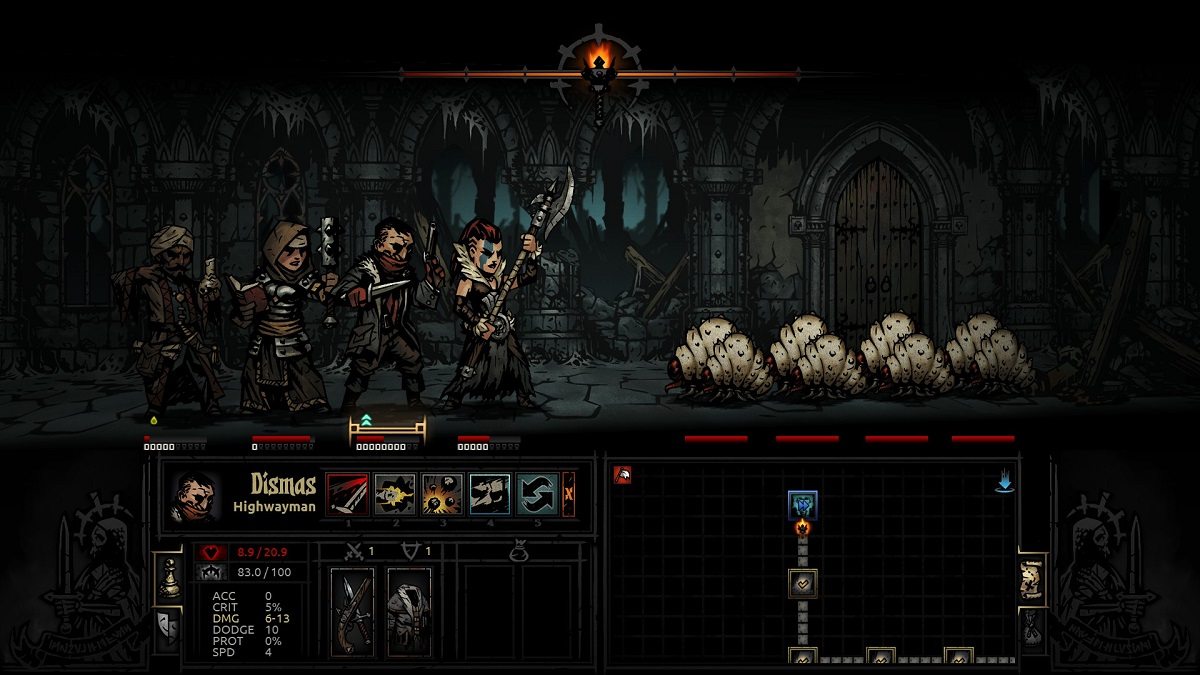
There’s a lot of depth in these systems, though. Building a party of four heroes is as simple as clicking on four portraits, but a well-balanced party isn’t just a collection of four different character classes that seem complementary. Your heroes move through the dungeon in four ranks, and their combat abilities are only usable from specific positions in the lineup. Abilities can also only target specific positions in the enemy lineup. Highly damaging melee attacks are usually only useful from the front ranks of your party and can only target the enemy’s front ranks, while pistol shots and arcane powers might only be available for heroes in the back ranks and might only target the enemy’s back ranks.
The best party you can make is one with a broad range of options for targeting the enemy, and it also includes some backup plans, as some abilities can push or pull their targets forward or backward. Worse yet, if your party is surprised, its lineup is scrambled at random. These situations force tough choices in combat. Do you use a turn to move your Hellion back to the frontmost rank or use one of her less powerful abilities that’s available from the third rank?
Even when every hero is in her desired spot, combat presents nerve-wracking decisions. Roll the dice on a single powerful sword swing to maybe kill that enemy warrior and open up the archer behind him for melee attack? Or use poison or bleeding effects to wear him down while your Witch Doctor uses stun attacks to keep the archer from attacking? As the death of a hero is permanent, and as the loss of one hero is often enough to doom the outcome of an expedition, you’ll wince every time your party suffers an extra attack or two that might have been avoided if you’d resolved a combat more efficiently and safely.

Making choices as hazards and curios present themselves in the dungeon is often simply a question of whether you have the tools necessary to ensure a safe outcome. Investigating that urn of ashes is probably a bad idea without Holy Water to consecrate it, and it seems nearly every locked chest has a trap ready to spring unless it’s opened with a Skeleton Key. But sometimes your hand is forced: your Witch Doctor with the Compulsive quirk might decide he’s opening that iron maiden, caution be damned, and you’ll watch helplessly as he’s impaled by horrible spikes.
Provisioning for your journey is therefore a guessing game, as you want to bring along everything you might need, but it all costs, and there’s never enough gold for everything you want. Inventory space is a concern, too, as food, torches, antivenom, and bandages will eventually compete with stacks of gold, precious gems, and heirlooms for space in your inventory during a successful dungeon run. Do you dump the Shovel so you can grab another stack of loot? What if a mound of rubble blocks a path further in the dungeon? The expendable tool makes clearing it an easy task, but without it, your heroes must undertake the Stressful job of doing so by hand. Provisions are only good for one expedition, and extra tools and supplies are lost at the end of a dungeon crawl. Buy enough before you venture forth, but don’t buy too much, because there’s never enough gold.
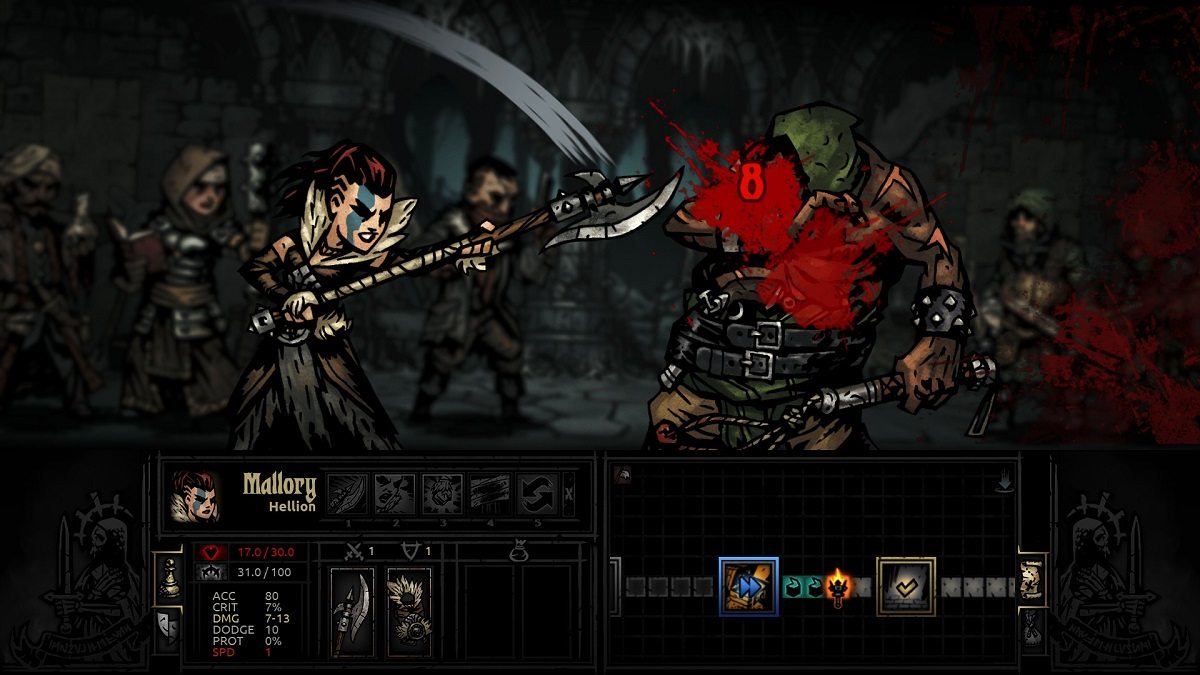
Your heroes gain experience for completing expeditions, increasing their ability to deal with Stress, and you can upgrade their equipment and abilities by spending gold in between dungeon crawls. And you’ll find that you have to, as the difficulty of available quests increases as game time passes. In its current form, there’s no actual end to the Campaign mode, and there’s some missing content–Red Hook promises this is all forthcoming, including more character classes and access to two of the five dungeon environments, notably the eponymous Darkest Dungeon, where one imagines the story will reach its conclusion–but a daunting checklist of goals already presents itself in the journal. Kill the Necromancer Apprentice? Kill the Swine Prince? Kill the Wizened Hag? Completing expeditions unlocks new dungeon environments and eventually allows you to challenge the bosses of each region. In my first battle with the Necromancer Apprentice, I quickly realized I was outmatched, fleeing combat and abandoning the quest without losing any of my heroes. I returned later and bested the Apprentice and felt a rush of accomplishment, then promptly fought my way to the Swine Prince and watched him smash my four best heroes like overripe fruit. My hero roster was decimated, and I started a new campaign with no hesitation.
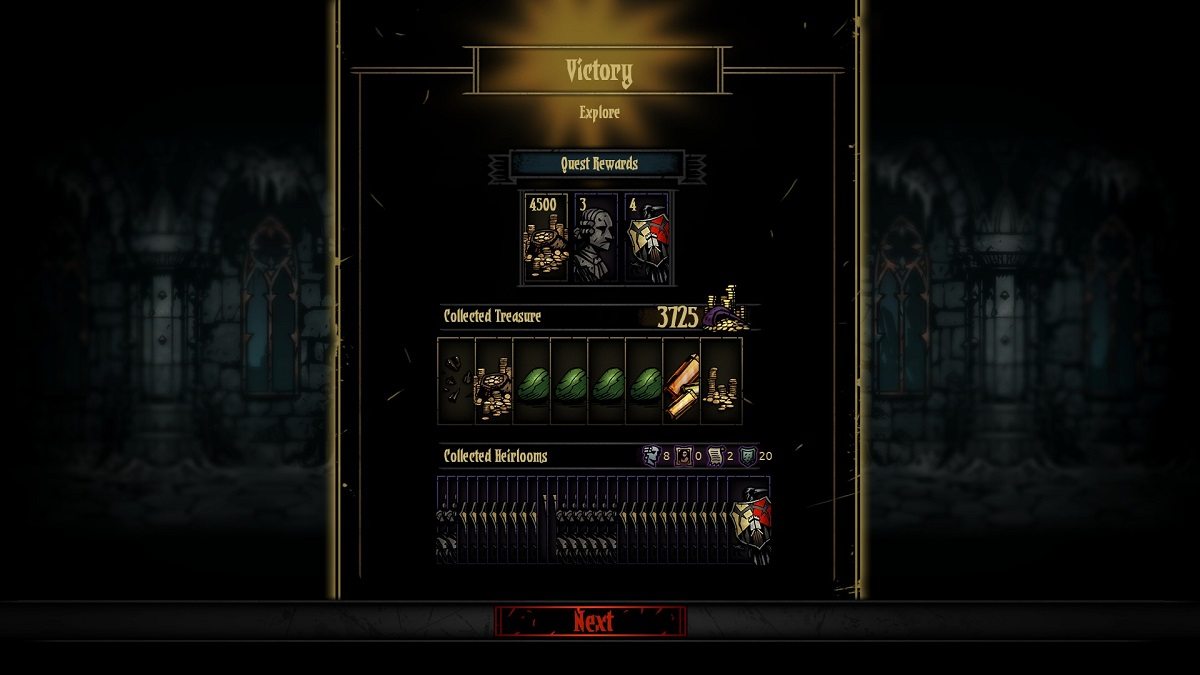
I watch Early Access games hit Steam with astonishing regularity these days, and, most of the time, I wonder who’s buying them. It’s great for developers that they can recoup some costs before a project is complete, and it’s surely useful to get real-time feedback from the most enthusiastic fans of a game. It’s also a boon to players who want to shape the final version of a game that excites them, assuming a development team is willing to engage with their early backers.
But I still feel the only Early Access games that can be recommended without reservation are those that offer an experience that already feels complete, and Darkest Dungeon checks this box with ink left over. It’s a fresh take on things we’ve seen in countless other games and offers unique hooks that would be enough to make it stand out, but its greatest achievement is the supremely designed interplay of all its moving parts. I’ve sunk ten hours into its current incarnation already, and I’m still hungry for more. Red Hook promises the game will get even better before a planned full release late this year, but I already feel like my money was well spent.





Excellent run-down. I echo your words, and add that the developers are very active in responding to the community of players. I found a couple of bugs and received a response within 12 hours of contacting them. Furthermore one of the bug’s I’d reported had been fixed for the next update, which I applied later that day!
They are listening so if you have any ideas or have found any bugs then don’t delay in sending an email to support@redhookgames.com because anyone can help make this game even better!
One of the few games in my Steam library that I come back to again and again and again. I really want to to succeed on a grand scale because I need me a set of pose-able or non-pose-able figures of these heroes and monsters (with dungeon cardboard backdrops). Better yet, hook up with Fantasy Flight and give us a randomized dungeon crawler where each player controls a party of four and has to manage stress and supplies in a race to kill the boss!
Yeah, I love this game.